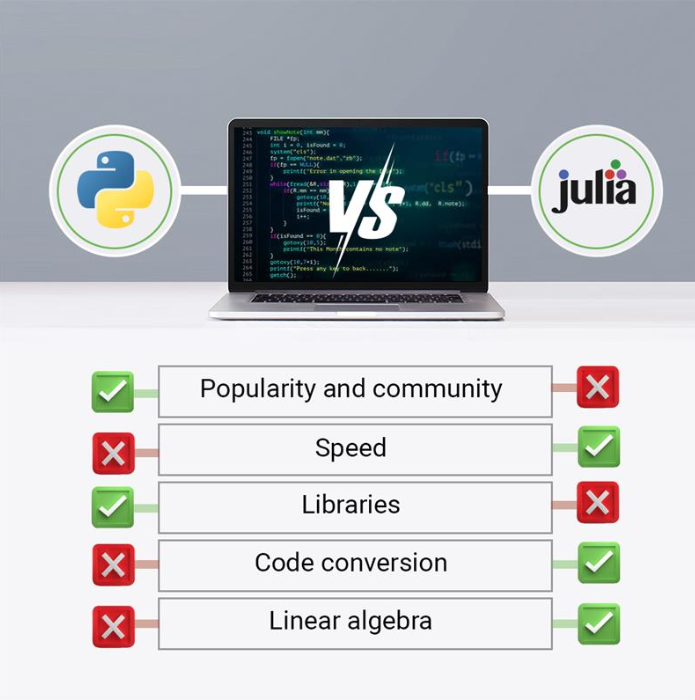This blog will discuss the strengths and limitations of Python and Julia to address a very common topic of debate; is Julia better than Python?
It is a high-level programming language that was designed in 2012, specifically for the Data Science and Machine Learning community. It was introduced as a mathematically oriented language and became popular for its speed and performance over other languages like Python and R.
Almost every introductory level course on Julia talks about its speed compared to Python, NumPy, and C, claiming that the performance of this language is as good as the speed of C. Also, it outperforms Python and NumPy but only by a margin. This leads to another debate; Will Julia conquer Python’s kingdom in Data Science?
To be able to address this question, let us dive deeper to compare several aspects of the two languages.

Popularity and community
Python has been operational for over 30 years and is one of the most popular programming languages right now with a large developer community offering solutions and help for potential problems. This makes Python much easier and more convenient to use than any other language.
Julia has a small but rapidly growing and active community. Even though the number of followers is constantly increasing for it; the majority of support is still provided by the writers themselves. It is expected that when the scope of this programming language expands outside of data science, the popularity of the language will increase.
Speed
It takes leverage upon other languages when it comes to its execution speed. It is a compiled language primarily written on its own base. Well-written code in it can be as fast as in C. It is an excellent solution for challenges related to data analysis and statistical computing.
Python is an interpreted language that is not famous for its speed. Self-implemented functions in Python can take a lot longer to compile as compared to Julia or C. Therefore, it uses libraries like NumPy, Sklearn, and TensorFlow to implement different functions and algorithms. These libraries provide implementations of algorithms that are much faster than Python but slower than Julia.
Libraries
Python offers an extensive range of libraries that can be simply imported, and their functions can be used. Python is also supported by a large number of third-party libraries.
Julia does not have much in its library collection and the packages are not very well maintained. This makes some implementations like neural networks a bit tedious. Due to the lack of libraries, the scope of it is also limited, as many tasks like web development cannot be performed with this language yet. However, considering the expectations of the growing community, we can expect more developed and well-maintained libraries from it soon.
Code conversion
One of the most fascinating features of Julia is converting code from other programming languages to it. It is a very straightforward process that is widely supported.
In Python, code conversion is much more difficult than in Julia, but it is still possible. Julia’s code can be shared with Python using the module named “PyCall.”
Linear algebra (Data Science algorithms)
Julia was made with the intention of being used in statistics and machine learning. It offers various methods and algorithms for linear algebra. These methods are quite easy to implement, and their syntax is very similar to mathematical expressions.
Python does not have its own pre-defined methods for linear algebra, so users work through libraries, such as NumPy for such implementations. These implementations are, however, not as simple to use as in Julia.
Will Julia replace Python?
It would be too early to say that Julia will replace Python in Data Science. Both have their respective advantages. It depends on your use case and preference.
Python has built the trust of its community for years, and it is not an easy task for Julia to announce itself in that community. But it is not impossible either. As the community of this language grows, more support would be available for people. With the growth in resources, maybe in the near future, This language would be a new norm in Data Science.
Upgrade your data science skillset with our Python for Data Science and Data Science Bootcamp training!
Written by Waasif Nadeem






